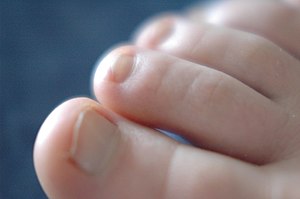 |
| (Photo credit: Wikipedia) |
Symptoms of toenail fungus outbreak include:
• Discoloration (may begin as a white or yellowish spot in the nail)
• Thickening
• Disfigurement
• Dry and crumbling nails
Nail fungus tends to affect more men than women and age is a factor due to lower blood circulation and greater time of exposure to fungus. Other factors that increase the likelihood of infection include:
• Damp environments
• Heavy perspiration
• Going barefoot at public pools, gyms and shower rooms
• Athletes foot
• An injured or damaged nail that allows infection to enter body
Dr. Blaakman will examine your feet first and may take a small scraping from under the nail. This can be examined through a microscope to determine the origination of the infection and better guide him in prescribing your treatment.
As previously mentioned, nail fungus can resist treatment and re-infection is common. There are over-the-counter medications available, but traditionally these have little effect. Dr. Blaakman may prescribe an oral medication, the most popular of which is Lamisil. The oral medications take a while to work, and it may take the nail months to grow back. However, persistence and patience is necessary.
Topical nail treatments are also a consideration either in the form or paint on or creams that are applied. Again, these take months to work, so they may be prescribed in conjunction with an oral medication. Dr. Blaakman may file away some of the affected nail so there is less area to treat and medication can be more easily absorbed. In the worst cases, Dr. Blaakman may recommend surgical removal of the nail, but the latest treatment using laser therapy to attack the fungus is showing promising results.
If you have nail fungus symptoms, don’t delay. Contact Upstate Footcare by calling (877) 941-3338 and let Dr. Blaakman evaluate your condition and determine the course of action appropriate for you.
If you have experienced the horror of nail fungus, and have successful treatment results, please share your story below.
References:
http://www.mayoclinic.com/health/nail-fungus/DS00084


